Saint Francis
Beginnings
A sermon on Mt 10:9, which Francis heard in 1209, made such an impression that he decided to devote himself entirely to a life of apostolic poverty. Clad in a rough garment, barefoot, and, after the Evangelical precept, he began to preach repentance without staff or scrip.
The mendicant orders had long been exempt from the bishop’s jurisdiction. They enjoyed (as distinguished from the secular clergy) unrestricted freedom to preach and hear confessions in the churches connected with their monasteries. This led to endless friction and open quarrels between the two divisions of the clergy. The Council of Trent definitively settled this question.
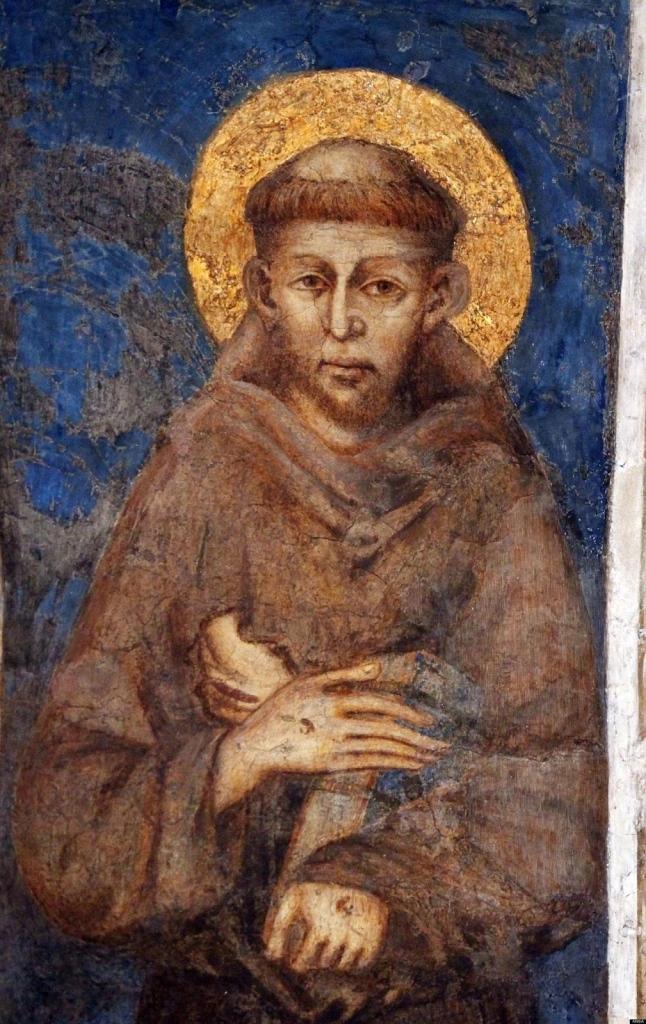
Francis of Assisi (born Giovanni di Pietro di Bernardone; Italian: Francesco d’Assisi; Latin: Franciscus Assisiensis; 1181 or 1182 – 3 October 1226), was an Italian Catholic friar, deacon, and mystic. He founded the men’s Order of Friars Minor, the women’s Order of St. Clare, the Third Order of St. Francis and the Custody of the Holy Land. Francis is one of the most venerated religious figures in Christianity. Pope Gregory IX canonized Francis on 16 July 1228. Along with Catherine of Siena, he was designated patron saint of Italy. He later became associated with patronage of animals and the natural environment, and it became customary for churches to hold ceremonies blessing animals on his feast day of 4 October. In 1219, he went to Egypt in an attempt to convert the sultan al-Kamil and put an end to the conflict of the Fifth Crusade. Once the Pope authorized his community, he withdrew increasingly from external affairs. Francis is known for his devotion to the Eucharist. In 1223, Francis arranged for the first Christmas live nativity scene. According to Christian tradition, in 1224, he received the stigmata during the apparition of a Seraphic angel in religious ecstasy.
Source: https://en.wikipedia.org/wiki/Francis_of_Assisi
Saint François d’Assise est un jeune homme issu d’une riche famille marchande — son père vend des tapis jusqu’en France, d’où le prénom de Francesco, qui mène une jeunesse dissipée. Il veut devenir chevalier et se fait emprisonner un an, à la suite d’une guerre entre sa ville, Assise, et la ville voisine de Pérouse. À la suite de sa détention, il tombe gravement malade et se convertit.
Il crée en 1209 une confrérie primitive, fondée sur la pauvreté totale et la prédication. Ses premiers compagnons sont Bernard de Quintavalle et Pierre de Catane. Saint François envoie ses confrères deux par deux dans toutes les régions autour d’Assise. Les frères vivent du travail de leurs mains et de l’aumône. Très vite, la communauté rencontre un très grand succès. En 1210, le pape Innocent III (dont le nom est choisi pour honorer les chrétiens tués sans raison) approuve verbalement la nouvelle communauté. Saint François choisit le nom de “frères mineurs” par référence aux « plus petits d’entre nous » dont parlent les Évangiles (Mt 25,40-45). En 1212, il est rejoint par sainte Claire, jeune fille d’une noble et riche famille, qui a été convertie par François. Ce sera la fondation de l’ordre des Pauvres Dames, les Clarisses, second ordre franciscain. En 1221, les franciscains s’agrandissent par la fondation du tiers-ordre, réservé aux séculiers. Saint François étend ainsi l’idéal biblique à tous et permet à chacun de se reconnaître dans le Christ sans renoncer au monde séculier. En 1217, une première organisation est donnée à l’ordre : l’Italie est découpée en provinces, chacune ayant à sa tête un « ministre provincial ». François s’oppose à toute forme d’organisation plus poussée. Parallèlement, des groupes de missionnaires sont envoyés en Palestine. Saint François lui-même part, laissant l’ordre entre les mains de deux vicaires généraux, parmi lesquels Pierre de Catane. Ceux-ci décident Honorius III à publier une bulle imposant un noviciat d’un an, une profession de vœux formelle et un contrôle de la prédication. À son retour en 1220, saint François s’oppose à ces changements. Contraint de donner une constitution formelle à l’ordre, il rédige la Regula Prima. Elle est basée sur le respect total des enseignements de Jésus-Christ. Jugée trop longue et trop stricte, elle est remplacée en 1223 par une seconde règle, elle aussi de la main de saint François, approuvée par la bulle Solet Annuere d’Honorius III, d’où son nom de Regula bullata. Cette règle beaucoup moins sévère est rédigée à la suite de tensions à l’intérieur de l’Ordre : une partie des frères considère que la pauvreté évangélique est trop dure à supporter et souhaite posséder des couvents ou encore des livres. Finalement saint François cède sous la pression de frère Hugolin et frère Élie. Il écrit en 1225 le Cantique de Frère Soleil. Il aurait reçu les stigmates de la Passion du Christ peu de temps avant sa mort. En 1220, saint François avait quitté la tête de l’ordre, et l’avait confié à Pierre de Catane, devenu son vicaire. À la mort de ce dernier en 1221, le vicariat passe à Élie de Cortone. Saint François d’Assise meurt en 1226, laissant un Testament où il professe son attachement à la pauvreté évangélique. En 1227, Élie de Cortone convoque un chapitre général, qui élit Giovanni Parenti ministre général. L’ordre des frères mineurs est le seul mouvement religieux chrétien pour lequel on peut parler d’une capitale, Assise, et d’un centre, l’Ombrie, du fait de l’empreinte laissée par François dans ces lieux.
Les franciscains portaient un froc de laine gris, avec une ceinture de corde et un capuchon court et arrondi.
Ils avaient le droit de se livrer dans leurs églises à la confession et à la prédication.
Le plan de la règle de 1223 est:
1. Prologue … observer le saint évangile de notre Seigneur JésusChrist, en vivant dans l’obéissance, sans rien en propre et dans la chasteté…. obéissance au Pape, à saint François et à ses successeurs à la tête de l’ordre.
2. De ceux qui veulent accepter cette vie et comment ils doivent être reçus
3. De l’office divin et du jeûne, et comment les frères doivent aller par le monde.
Pour les clercs, … pour les laïcs, office divin … prière, … jeune … Je conseille, j’avertis et j’exhorte mes frères dans le Seigneur Jésus-Christ: quand ils vont par le monde, qu’ils ne se disputent pas, qu’ils ne se querellent pas en paroles et qu’ils ne jugent pas les autres; mais qu’ils soient doux, pacifiques et modestes, aimables et humbles, parlant honnêtement à tous, comme il convient. Et ils ne doivent pas aller à cheval, s’ils n’y sont pas contraints par une nécessité manifeste ou par la maladie. En quelque maison qu’ils entrent, qu’ils disent d’abord: Paix à cette maison.
4. Que les frères ne reçoivent pas d’argent.
5. De la manière de travailler.
6. Que les frères ne s’approprient rien de l’aumône â demander et des frères malades
Que les frères ne s’approprient rien, ni maison, ni lieu, ni quoi que ce soit. Et comme des pèlerins et des étrangers en ce siècle, servant le Seigneur dans la pauvreté et l’humilité, qu’ils aillent à l’aumône avec confiance, et il ne faut pas qu’ils en aient honte, car le Seigneur s’est fait pauvre pour nous en ce monde.
7. De la pénitence à imposer aux frères qui pèchent.
8. De l’élection du ministre général et du chapitre de la Pentecôte
9. Des prédicateurs.
10. De l’admonition et de la correction des frères.
11. Que les frères n’entrent pas dans les monastères de moniales.
12. De ceux qui vont chez les sarrasins et autres païens.

Dès la mort du fondateur, les conflits éclatent. En 1230, le pape Grégoire IX dispense les franciscains de suivre le testament du fondateur. En 1244, Crescence de Jesi, futur ministre général de l’ordre, contient des rebellions dans la Marche d’Ancône où il est ministre provincial ; il fait capturer et envoyer 72 frères mineurs qui refusent l’allégement du voeu de pauvreté en portant une tenue vestimentaire particulièrement indigente4 dans les provinces reculées franciscaines. L’ordre est normalisé par saint Bonaventure, ministre général de 1257 à 1274 : on insiste moins sur la pauvreté et on s’intéresse aux activités intellectuelles et pastorales. Une tendance s’oppose à cette évolution et tient à conserver la pauvreté absolue vantée par saint François d’Assise. Ce sont les Spirituels, aussi appelés zelanti en Italie ; les plus extrémistes d’entre eux formeront le groupe des fraticelles, très marqués par la pensée eschatologique et apocalyptique de Joachim de Flore. Leurs foyers spirituels se situent dans le Languedoc (Pierre-Jean Olieu, ou Pierre de Jean Olivi), en Toscane (Ubertin de Casale) et dans les Marches (Ange Clareno, Pierre de Macerata). C’est pourquoi ils sont vite accusés d’hérésie. En 1323, le pape Jean XXII règle la question de la pauvreté en déclarant par sa bulle Cum inter nonnullos que la pauvreté de Jésus et des apôtres n’a pas été absolue. Bon nombre de spirituels sont emprisonnés et les fraticelles sont livrés à l’Inquisition ; et les meneurs meurent sur le bûcher ou en prison au xive siècle. Les spirituels renaissent cependant sous la forme des frères mineurs observants (fusion de diverses branches, les claréniens, colettan, amadéens, etc.), famille créée en 1517 par la bulle Ite et vos du pape Léon X.
Clare of Assisi
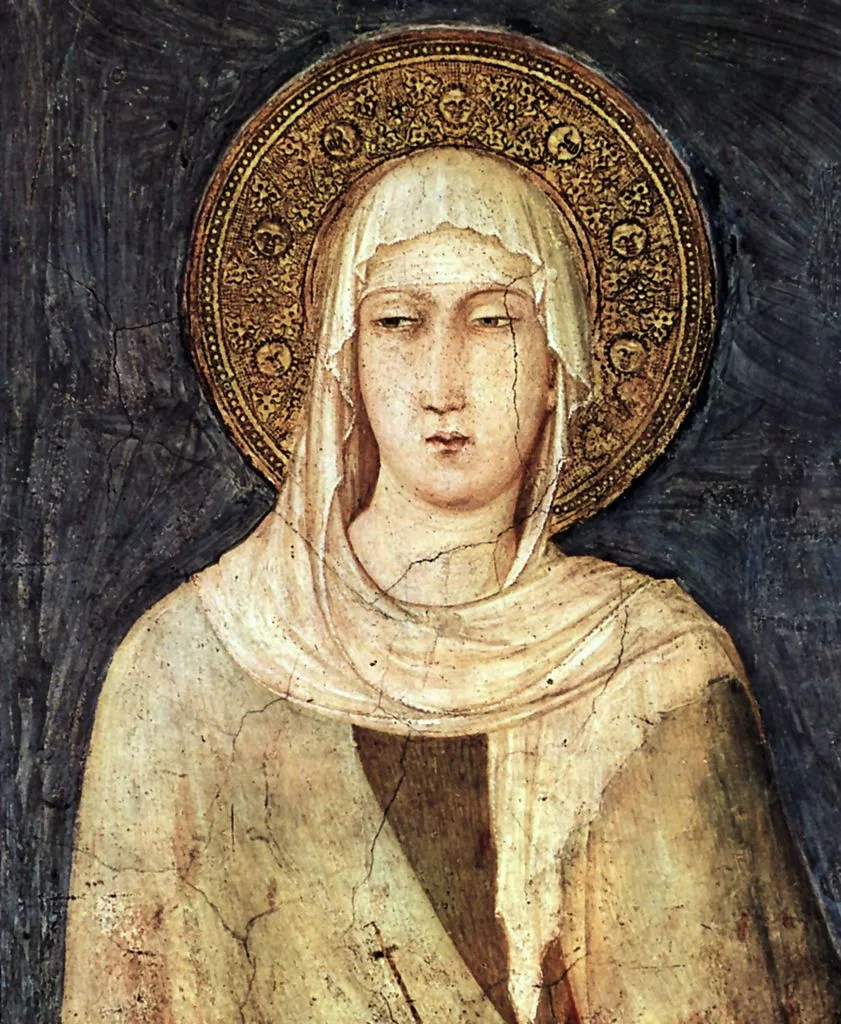
Clare of Assisi (born Chiara Offreduccio and sometimes spelled Clara, Clair, Claire, Sinclair; 16 July 1194 – 11 August 1253) was an Italian saint and one of the first followers of Francis of Assisi. She founded the Order of Poor Ladies, a monastic religious order for women in the Franciscan tradition. She wrote their Rule of Life, the first set of monastic guidelines known to have been written by a woman. Following her death, the order she founded was renamed in her honour as the Order of Saint Clare, commonly referred to today as the Poor Clares. Her feast day is on 11 August.
Source: https://en.wikipedia.org/wiki/Clare_of_Assisi
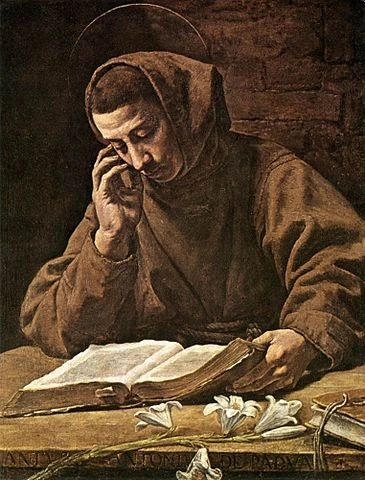
St Anthony Reading
Marcantonio Bassati
Saint Anthony’s Quote: “Actions speak louder than words; let your words teach, and your actions speak.
Anthony’s fame spread through Portuguese evangelization, and he has been known as the most celebrated of Francis of Assisi’s followers. He is the patron saint of Lisbon, Padua, and many places in Portugal and the countries of the former Portuguese Empire.
He is especially invoked and venerated worldwide as the patron saint of the recovery of lost items and is credited with many miracles involving lost people, things, and even spiritual goods. St. Anthony’s Chaplets help devotees meditate on the saint’s thirteen virtues. Some of these chaplets were used by members of confraternities that had Anthony as their patron saint.
Anthony of Padua (Portuguese: António de Pádua; born Fernando Martins de Bulhões; 15 August 1195 –13 June 1231), also known as Anthony of Lisbon (Portuguese: António de Lisboa), was a Portuguese Catholic priest and friar of the Franciscan Order. He was born and raised by a wealthy family in Lisbon, Portugal, and died in Padua, Italy. Noted by his contemporaries for his powerful preaching, expert knowledge of scripture, and undying love and devotion to the poor and the sick, he was one of the most quickly canonized saints in church history. He was proclaimed a Doctor of the Church on 16 January 1946. He is also the patron saint of lost things.
After his ordination to the priesthood, Fernando was named guestmaster at 19 and placed in charge of hospitality for the abbey. While he was in Coimbra, some Franciscan friars arrived and settled at a small hermitage outside Coimbra dedicated to Anthony of Egypt. Fernando was strongly attracted to the straightforward, evangelical lifestyle of the friars, whose order had been founded only 11 years prior. News arrived that five Franciscans had been beheaded in Morocco, the first of their order to be killed. King Afonso II ransomed their bodies to be returned and buried as martyrs in the Abbey of Santa Cruz. Inspired by their example, Fernando obtained permission from church authorities to leave the Canons.
Regular to join the new Franciscan order. Upon his admission to the friars’ life, he joined the small hermitage in Olivais, adopting the name Anthony (from the name of the chapel dedicated to Anthony the Great), by which he was to be known.
Anthony then set out for Morocco in fulfillment of his new vocation. However, he fell seriously ill in Morocco and set sail back for Portugal in the hope of regaining his health. On the return voyage, the ship was blown off course and landed in Sicily.
From Sicily, he made his way to Tuscany, where he was assigned to a convent of the order. However, he encountered difficulty because of his sickly appearance. He was finally assigned to the rural hermitage of San Paolo near Forlì, Romagna, a choice made after considering his poor health. There, he had recourse to a cell one of the friars had made in a nearby cave, spending time in private prayer and study.
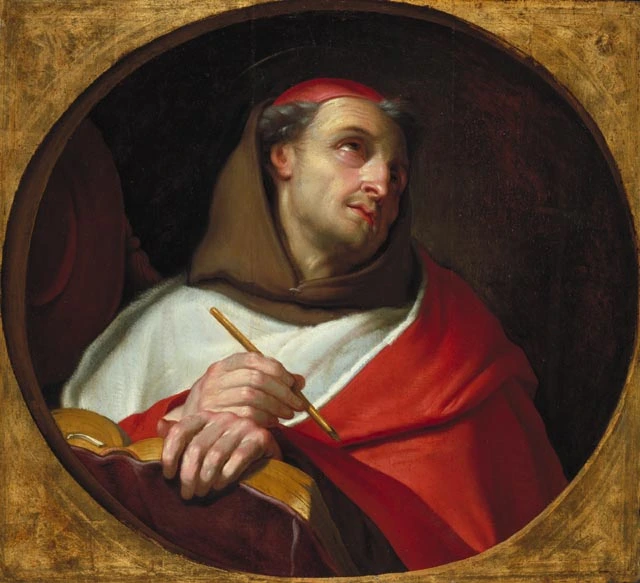
Saint Bonaventure
Bonaventure Latin: Bonaventura de Balneoregio; 1221 – 15 July 1274), born Giovanni di Fidanza, was an Italian Catholic Franciscan, bishop, cardinal, scholastic theologian and philosopher. The seventh Minister General of the Order of Friars Minor, he also served as Bishop of Albano. He was canonized on 14 April 1482 by Pope Sixtus IV and declared a Doctor of the Church in 1588 by Pope Sixtus V. He is known as the “Seraphic Doctor” (Latin: Doctor Seraphicus). His feast day is 15 July. Many writings believed in the Middle Ages to be his are now collected under Pseudo-Bonaventure.
Saint Bonaventure (o.f.m.), né à Bagnorea (actuelle Bagnoregio, près d’Orvieto en Italie) en 1217-1218 ou 1221, sous le nom de Giovanni di Fidanza, mort à Lyon dans la nuit du 14 au 15 juillet 1274, est un religieux italien. Il prit le nom de Bonaventure lors de son entrée dans les ordres. Théologien, archevêque, cardinal, Docteur de l’Église, ministre général des Franciscains, il est, à l’instar de Jean Duns Scot et Thomas d’Aquin, l’un des piliers de la théologie chrétienne au Moyen Âge. Surnommé le « Docteur séraphique » (Doctor seraphicus), canonisé en 1482, il reste connu sous le nom de « saint Bonaventure ». Il est célébré par l’Église catholique le 15 juillet.
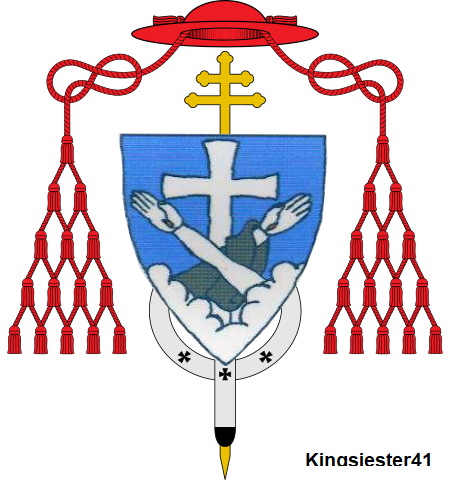
Histoire sur Wikipedia History on Wikipedia
Saint Joseph of Cupertino
Saint Francis Anthony Fasani
Saint Maximilian Kolbe
Friar Roger Bacon
Ottoman & Franciscan
Jerusalem in 1896 | Jews, Muslims, Christians living under the Ottomans

The Church of the Holy Sepulchre is one of the holiest and most special sites in Christianity. Located in the Christian Quarter of the Old City of Jerusalem, the church is home to two of the holiest sites in Christianity, the site where Jesus was crucified, known as Calvary, and the tomb where Jesus was buried and then resurrected. Today, the tomb is enclosed by a shrine called the Aedicula. The final four Stations of the Cross, or Via Dolorosa, are also located inside the church.
Procession on the parvis of the Church of the Holy Sepulchre headed by Kawas (Ottoman guards).
Français : Jérusalem, Eglise du Saint-Sépulcre – Une procession sur le parvis de l’église avec à sa tête deux “kavas” ou “Kawas” ou “kawass” (gardes du vizir ottoman et officiers de police de l’Empire Ottoman jusqu’en 1908) en costume traditionnel, coiffés du tarbouche (Fez) et en pantalon bouffant, qui martèlent le sol de leurs lourdes cannes ferrées au pommeau d’argent.
Author: מוחמד מוסא שהואן
This file has been submitted through the Israeli Pikiwiki project and uploaded here automatically. The project is a cooperation between the Israel Internet Association and Wikimedia Israel in an effort to promote the concept of free content on the Web, by creating an image collection of digital-format, good quality photographs, documenting events relating to the history of Israel, or depicting places of distinction in Israel and the Middle East.
The protectorate began to assume a contractual form in the sixteenth century, in the treaties concluded between the kings of France and the Ottoman Sultans, which are historically known as Capitulations. At first, this name designated the commercial agreement conceded by the Sublime Porte to Latin merchants (first to the Italians), and arose from the fact that the articles of these agreements were called capitoli (‘chapters’ in the Italian redaction); the term does not have the same humiliating meaning as in military parlance (conceding utter defeat), but a similar neutral etymology as the Carolingian Capitularia.
Francis I was the first king of France who sought an alliance with Turkey. He was urged to this, not by the spirit of the Crusaders, but entirely by the desire to break into Europe the dominating power of the imperial Habsburg House of Austria. By compelling Austria to spend its forces in defence against the Turks in the East, he hoped to weaken it and render it unable to increase or even maintain its power in the West.
The next French kings down to Louis XV followed the same policy, which was as a matter of fact favourable to Christianity in the Levant, seeking by their zeal in defending Christian interests at the Sublime Porte (Ottoman government), to extenuate their alliance with non-Christians, which was a source of scandal even in France. As early as 1528, Francis I had appealed to Suleiman the Magnificent to restore to the Christians of Jerusalem a church that the Turks had converted into a mosque. The Sultan refused the plea that his religion would not permit alteration of the purpose of a mosque, but he promised to maintain the Christians in possession of all the other places occupied by them and to defend them against all oppression.
However, religion was not the object of a formal convention between France and Turkey prior to 1604, when Henry IV of France secured from Ahmad I the insertion, in the capitulations of 20 May, of two clauses relative to the protection of pilgrims and of the religious in charge of the Church of the Holy Sepulchre. The following are the relevant clauses of the treaty: “Article IV. We also desire and command that the subjects of the said Emperor of France, and those of the princes who are his friends and allies, may be free to visit the Holy Places of Jerusalem, and no one shall attempt to prevent them nor do them injury”; “Article V. Moreover, for the honour and friendship of this Emperor, we desire that the religious living in Jerusalem and serving the church of Comane the Resurrection may dwell there, come and go without let or hindrance, and be well received, protected, assisted, and helped in consideration of the above.” It is noteworthy that the same advantages are stipulated for the French and for the friends and allies of France, but for the latter in consideration of, and at the recommendation of France.
The result of this friendship was the development of the Catholic missions, which began to flourish through the assistance of Henry IV Bourbon and his son Louis XIII Bourbon and through the zeal of the French missionaries. Before the middle of the seventeenth century, various religious orders (Capuchin, Carmelite, Dominican, Franciscan and Jesuit) were established, as chaplains of the French ambassadors and consuls, in major Ottoman cities (Istanbul, Alexandria, Smyrna, Aleppo, Damascus, etc.), Lebanon and the islands of the Aegean Archipelago. They assembled the Catholics to instruct and confirm them in the Catholic faith, opened schools to which flocked the children of all rites, relieved the spiritual and corporal miseries of the Christians in the Turkish prisons, and nursed the pest-stricken, which the last office made many martyrs of charity.
During the reign of Louis XIV, the missionaries multiplied and extended the field of their activities: the Sun King gave them at once material and moral support, which the prestige of his victories and conquests rendered irresistible at the Porte. Thanks to him, the often precarious tolerance, on which the existence of the missions had previously depended, was officially recognized in 1673, when on 5 June, Mehmed IV not only confirmed the earlier capitulations guaranteeing the safety of pilgrims and the religious guardians of the Holy Sepulchre but signed four new articles, all beneficial to the missionaries. The first decreed in a general manner “that all bishops or other religious of the Latin sect (CFR. Millet (Ottoman Empire)) who are subjects of France, whatever their condition, shall be throughout our empire as they have been hitherto, and may there perform their functions, and no one shall trouble or hinder them”; the others secure the tranquil possession of their churches, explicitly to the Jesuits and Capuchins, and in general “to the French at Smyrna, Saïd, Alexandria, and in all other ports of the Ottoman Empire”.
The reign of Louis XIV marked the apogee of the French Protectorate in the East, for not only the Latin missionaries of all nationalities, but also the heads of all Catholic communities, regardless of rite or nationality, appealed to the king, and at the recommendation of his ambassadors and consuls to the Porte and the pashas, obtained justice and protection from their enemies. Though the missionaries were sometimes on such amicable terms with the non-Catholic clergy that the latter authorized them to preach in their churches, they usually experienced a lively hostility from that quarter. On several occasions, the Greek and Armenian Non-Uniate Patriarchs, displeased at seeing a great portion of their flocks abandon them for the Roman priests, on various pretexts persuaded the Turkish government to forbid all propaganda by the latter, but representatives of Louis XIV successfully opposed this ill will.
At the beginning of the reign of Louis XV, the preponderance of French influence with the Porte was also manifested in the authority granted the Franciscans, who were protégés of France, to repair the dome of the Holy Sepulchre: this meant the recognition of their right of proprietorship in the Holy Sepulchre as superior to the claims of the Greeks and the Armenians.
In 1723 the Non-Uniate Patriarchs succeeded in obtaining from the Sultan a “command” forbidding his Christian subjects to embrace the Roman religion, and the Latin religion o hold any communication with the Greeks, Armenians and Syrians, on the pretext of instructing them. French diplomacy sought, long in vain, to have this measure revoked. At last, as a reward for the services rendered to Turkey during its wars with Russia and Austria (1736–1739), the French succeeded in 1740 in securing the renewal of the capitulations, with additions which explicitly confirmed the right of the French Protectorate, and at least implicitly guaranteed the liberty of the Catholic apostolate. By the eighty-seventh of the articles signed on 28 May 1740, Sultan Mahmud I declared: “… The bishops and religious subjects to the Emperor of France living in my empire shall be protected while they confine themselves to the exercise of their office, and no one may prevent them from practising their rite according to their custom in the churches in their possession, as well as in the other places they inhabit; and, when our tributary subjects and the French hold intercourse for purposes of selling, buying, and other business, no one may molest them for this sake in violation of the sacred laws.”
In subsequent treaties between France and Turkey, the capitulations were not repeated verbatim, but they are recalled and confirmed (e. g. in 1802 and 1838). The various regimes which succeeded the monarchy of Louis IX of France and of Louis XIV all maintained in law, and in fact, the ancient privilege of France in the protection of the missionaries and Christian communities of the Orient. The expedition in 1860 sent by Emperor Napoleon III to put a stop to the massacre of the Maronites was in harmony with the ancient rôle of France,, and would have been more so if its work of justice had been more complete.
https://en.wikipedia.org/wiki/Protectorate_of_missions
To talk about Franciscans, nobody else can do it better
than Casey Cole’s YouTube Videos
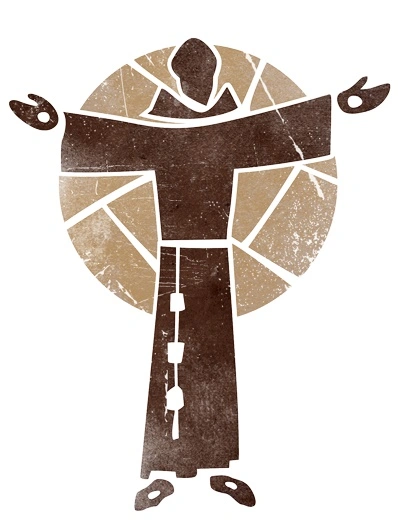
The Franciscans are a group of related mendicant Christian religious orders, primarily within the Catholic Church. Founded in 1209 by Saint Francis of Assisi, these orders include the Order of Friars Minor, the Order of Saint Clare, and the Third Order of Saint Francis. They adhere to the teachings and spiritual disciplines of the founder and of his main associates and followers, such as Clare of Assisi, Anthony of Padua, and Elizabeth of Hungary. Several smaller Protestant Franciscan orders exist as well, notably in the Anglican and Lutheran traditions (e.g. the Community of Francis and Clare).
Francis began preaching around 1207 and travelled to Rome to seek approval from Pope Innocent III in 1209 to form a new religious order. The original Rule of Saint Francis approved by the Pope did not allow ownership of property, requiring members of the order to beg for food while preaching. The austerity was meant to emulate the life and ministry of Jesus Christ. Franciscans travelled and preached in the streets while staying in church properties. Saint Clare, under Francis’s guidance, founded the Poor Clares (Order of Saint Clare) of the Franciscans.
The extreme poverty required of members was relaxed in the final revision of the Rule in 1223. The degree of observance required of members remained a major source of conflict within the order, resulting in numerous secessions. The Order of Friars Minor, previously known as the “Observant” branch, is one of the three Franciscan First Orders within the Catholic Church, the others being the “Conventuals” (formed 1517) and “Capuchins” (1520). The Order of Friars Minor, in its current form, is the result of an amalgamation of several smaller orders completed in 1897 by Pope Leo XIII. The latter two, the Capuchin and Conventual, remain distinct religious institutes within the Catholic Church, observing the Rule of Saint Francis with different emphases. Conventual Franciscans are sometimes referred to as minorities or Greyfriars because of their habit. In Poland and Lithuania, they are known as Bernardines, after Bernardino of Siena, although the term elsewhere refers to Cistercians instead.

The name of the original order, Ordo Fratrum Minorum (Friars Minor, literally ‘Order of Lesser Brothers’) stems from Francis of Assisi’s rejection of extravagance. Francis was the son of a wealthy cloth merchant but gave up his wealth to pursue his faith more fully. He had cut all ties that remained with his family and pursued a life living in solidarity with his fellow brothers in Christ. Francis adopted the simple tunic worn by peasants as the religious habit for his order and had others who wished to join him do the same. Those who joined him became the original Order of Friars Minor.
First Order
The First Order or the Order of Friars Minor are commonly called simply the Franciscans. This order is a mendicant religious order of men, some of whom trace their origin to Francis of Assisi. Their official Latin name is the Ordo Fratrum Minorum. St. Francis thus referred to his followers as “Fraticelli”, meaning “Little Brothers”. Franciscan brothers are informally called friars or the Minorites. The modern organization of the Friars Minor comprises three separate families or groups, each considered a religious order in its own right under its own minister General and a particular type of governance. They all live according to a body of regulations known as the Rule of St Francis. The Order of Friars Minor, also known as the Observants, are most commonly simply called Franciscan friars, official name: Friars Minor (OFM). The Order of Friars Minor Capuchin or simply Capuchins, official name: Friars Minor Capuchin (OFM Cap.). The Conventual Franciscans or Minorites, official name: Friars Minor Conventual (OFM Conv.).
Second Order
The Second Order, most commonly called Poor Clares in English-speaking countries, consists of only one branch of religious sisters. The order is called the Order of St. Clare (OSC), but before 1263 they were called “The Poor Ladies,” “The Poor Enclosed Nuns,” and “The Order of San Damiano.”
Third Order
The Franciscan third order, known as the Third Order of Saint Francis, has many men and women members, separated into two main branches:
The Secular Franciscan Order, OFS, originally known as the Brothers and Sisters of Penance or Third Order of Penance, try to live the ideals of the movement in their daily lives outside of religious institutes.
Members of the Third Order Regular (TOR) live in religious communities under the traditional religious vows. They grew out of the Secular Franciscan Order.
The 2013 Annuario Pontificio gave the following figures for the membership of the principal male Franciscan orders:.
- Order of Friars Minor (OFM): 2,212 communities; 14,123 members; 9,735 priests
- Franciscan Order of Friars Minor Conventual (OFM Conv.): 667 communities; 4,289 members; 2,921 priests
- Franciscan Order of Friars Minor Capuchin (OFM Cap.): 1,633 communities; 10,786 members; 7,057 priests
- Third Order Regular of Saint Francis (TOR): 176 communities; 870 members; 576 priests
The coat of arms, which is a universal symbol of Franciscans, “contains the Tau cross, with two crossed arms: Christ’s right hand with the nail wound and Francis’ left hand with the stigmata wound.”
Source: https://en.wikipedia.org/wiki/Franciscans
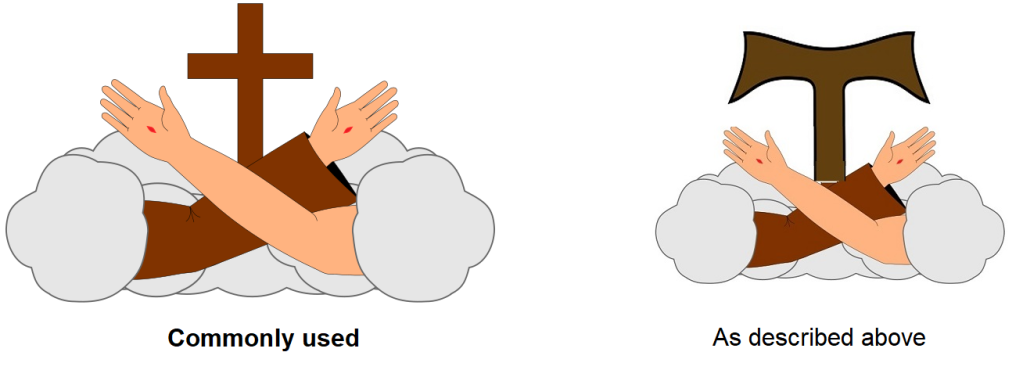
The Order of Friars Minor (the Franciscans, the Franciscan Order, or the Seraphic Order; postnominal abbreviation OFM) is a mendicant Catholic religious order founded in 1209 by Francis of Assisi. The order adheres to the teachings and spiritual disciplines of the founder and of his main associates and followers, such as Clare of Assisi, Anthony of Padua, and Elizabeth of Hungary, among many others. The Order of Friars Minor is the largest of the contemporary First Orders within the Franciscan movement.
Francis began preaching around 1207 and travelled to Rome to seek approval of his order from Pope Innocent III in 1209. The original Rule of Saint Francis, approved by the pope, disallowed property ownership, requiring members of the order to beg for food while preaching. The austerity was meant to emulate the life and ministry of Jesus Christ. Franciscans travelled and preached in the streets while boarding in church properties. The extreme poverty required of members was relaxed in the final revision of the Rule in 1223. The degree of observance required of members remained a primary source of conflict within the order, resulting in numerous secessions.
The Order of Friars Minor, previously known as the Observant branch (postnominal abbreviation OFM Obs.), is one of the three Franciscan First Orders within the Catholic Church, the others being the Capuchins (postnominal abbreviation OFM Cap.) and Conventuals (postnominal abbreviation OFM Conv). In its current form, the Order of Friars Minor is the result of an amalgamation of several smaller Franciscan orders (e.g. Alcantarines, Recollects, Reformanti, etc.), completed in 1897 by Pope Leo XIII. The Capuchin and Conventual remain distinct religious institutes within the Catholic Church, observing the Rule of Saint Francis with different emphases. Franciscans are sometimes referred to as minorites or greyfriars because of their habit. In Poland and Lithuania, they are known as Bernardines, after Bernardino of Siena, although the term elsewhere refers rather to Cistercians.
L’ordre des Frères mineurs (O.F.M.), en latin : Ordo Fratrum Minorum, dont les membres sont couramment appelés franciscains, est un ordre religieux catholique apparu en Italie en 1210 sous l’impulsion de saint François d’Assise.
À l’imitation du Christ, ses membres tentent de vivre une vie de pauvreté et de simplicité évangélique. Insistant sur l’aspect de fraternité dans leur vie, les franciscains ont choisi de s’appeler « frères ». Aujourd’hui, la majorité d’entre eux sont prêtres.
Quatre penseurs ont marqué l’histoire de cet ordre mendiant : saint Bonaventure de Bagnoregio, Roger Bacon, Jean Duns Scot et Guillaume d’Ockham.
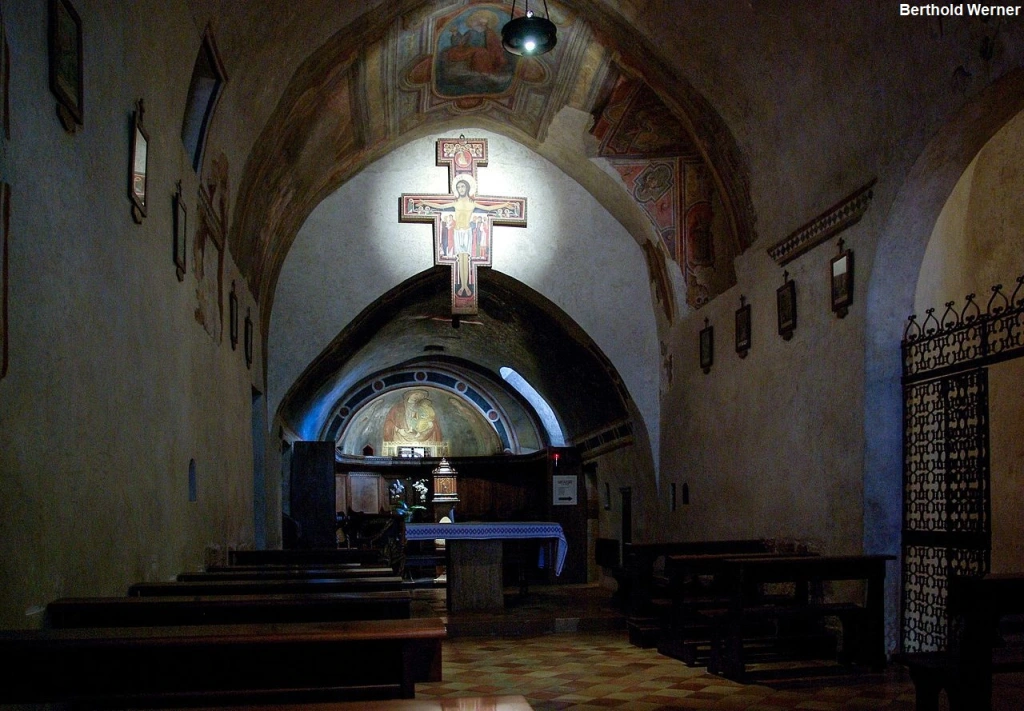
Over the centuries, the Franciscan monks have taken various names: Franciscans, Capuchins, Conventuals, Observants, Reformed, Discalced, Alcantarins, and Récollets.
Les moines Franciscains prirent divers noms au cours des siècles: Franciscains, Capucins, Conventuels, Observants, Réformés, Déchaussés, Alcantarins et Récollets
The Franciscans are a group of related mendicant Christian religious orders within the Catholic Church. Founded in 1209 by Italian Catholic friar Francis of Assisi, these orders include three independent orders for men (the Order of Friars Minor being the most significant contemporary male order), orders for women religious such as the Order of Saint Clare, and the Third Order of Saint Francis open to male and female members. They adhere to the teachings and spiritual disciplines of the founder and his main associates and followers, such as Clare of Assisi, Anthony of Padua, and Elizabeth of Hungary. Several smaller Protestant Franciscan orders exist, notably in the Anglican and Lutheran traditions (e.g. the Community of Francis and Clare).
Francis began preaching around 1207 and travelled to Rome to seek approval from Pope Innocent III in 1209 to form a new religious order. The original Rule of Saint Francis approved by the Pope did not allow property ownership, requiring members of the order to beg for food while preaching. The austerity was meant to emulate the life and ministry of Jesus Christ. Franciscans travelled and preached in the streets while staying in church properties. Under Francis’s guidance, Clare of Assisi founded the Poor Clares (Order of Saint Clare) of the Franciscans.
The extreme poverty required of members was relaxed in the final revision of the Rule in 1223. The degree of observance required of members remained a primary source of conflict within the order, resulting in numerous secessions. The Order of Friars Minor, previously known as the “Observant” branch, is one of the three Franciscan First Orders within the Catholic Church, the others being the “Conventuals” (formed 1517) and “Capuchins” (1520). The Order of Friars Minor, in its current form, is the result of an amalgamation of several smaller orders completed in 1897 by Pope Leo XIII. The latter two, the Capuchin and Conventual, remain distinct religious institutes within the Catholic Church, observing the Rule of Saint Francis with different emphases. Conventual Franciscans are sometimes called minorites or greyfriars because of their habit. In Poland and Lithuania, they are known as Bernardines, after Bernardino of Siena, although the term elsewhere refers to Cistercians.
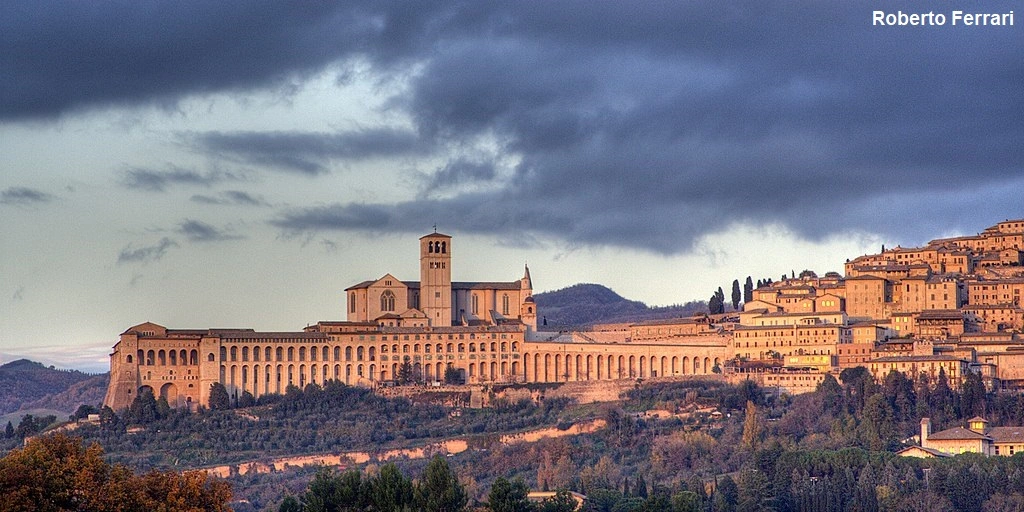
L’histoire des ordres franciscains retrace l’origine et le développement des trois ordres du mouvement franciscain. Fondé sur la pensée et les actions de François d’Assise, ce mouvement monachique est connu pour les idéaux de pauvreté et de fraternité qu’il véhicule. Si les franciscains sont principalement vus à travers l’ordre principal des frères mineurs ou celui des capucins, des ordres féminins et un ordre laïque appartiennent également à ce courant. L’ordre des frères mineurs apparaît en 1209. Son développement est très rapide et le mouvement devient l’un des courants monachiques les plus influents au Moyen Âge. Si l’ordre des frères mineurs a progressivement perdu la place dominante qu’il occupait au Moyen Âge, le mouvement franciscain reste vivace à travers les époques, notamment grâce à la fondation de nouveaux ordres, et continue d’influencer profondément la société. Par exemple, l’abbé Pierre et le père Joseph, dont les actions ont profondément marqué la société française moderne, furent tous deux capucins.
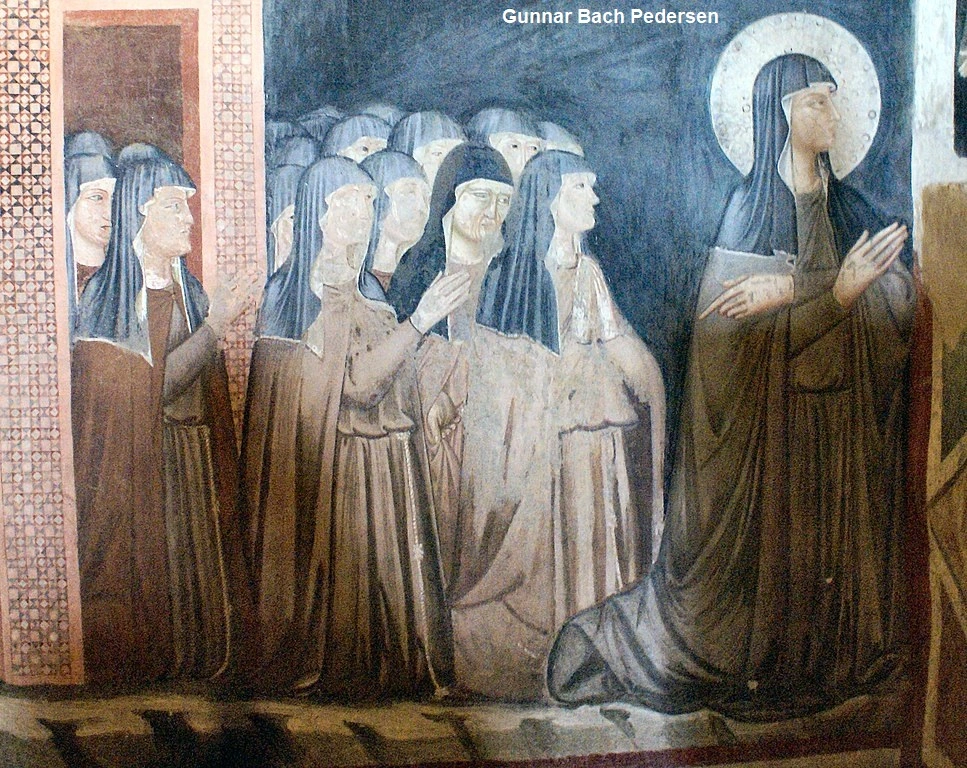
Saint Clare
Convent of Saint Clare
This convent became the home of Saint Clare of Assisi and her followers in 1212. Work was carried out to provide buildings for this religious community. The Sisters stayed until Clare’s death in 1253, when it was thought too dangerous to remain, and they were exchanged with the Canons of San Rufino for the chapel of San Giorgio. The convent is open free of charge to the public. Downstairs off the abbey is the refectory in its original state. A fresco in the refectory recalls the visit of Pope Gregory IX when he asked Clare to bless the loaves, which is said to have resulted in crosses appearing on the loaves. Upstairs is St. Clare’s Oratory, where the Blessed Sacrament was kept, and next to this is the dormitory. A cross marks the place where Clare died on 11 August 1253
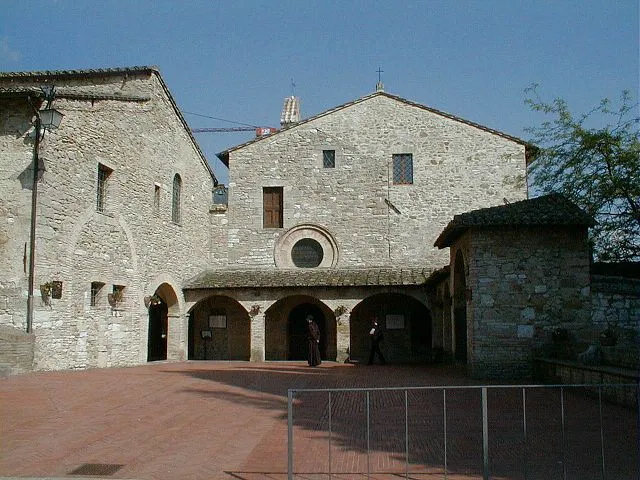
San Damiano
San Damiano is a church with a monastery near Assisi, Italy. Built in the 12th century, it was the first monastery of the Order of Saint Clare, where Saint Clare built her community. The church has a hut-shaped façade; the entrance is preceded by a short portico with three round arcades supported by brickwork pillars. Above the central arch is a circular rose window. The interior has a single nave with ogival barrel vaults. The right wall is home to a rectangular chapel with, at the altar, a wooden crucifix executed by Innocenzo da Petralia in 1637. The nave ends with a deep apse, a modern stone altar, a Baroque wooden tabernacle, and a choir.
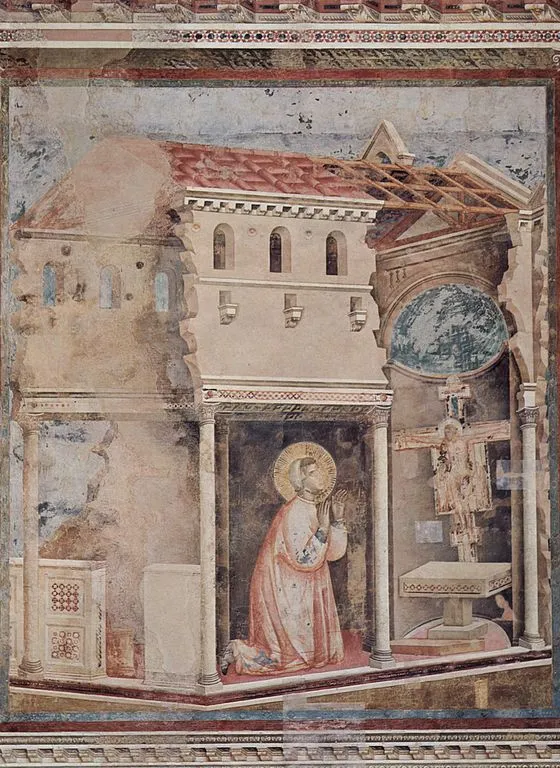
According to Franciscan sources, a miracle in which Saint Francis’ heard an exhortation from Christ occurred in 1205 in this church:
One day, I was out in the countryside to meditate. Finding himself near San Damiano, which threatened ruin, old as it was, driven by the impulse of the Holy Spirit, he entered to pray. Kneeling in prayer before the image of the Crucifix, he was invaded with great spiritual consolation and, as he affixed his tearful eyes on the cross of the Lord, with the ears of his body he heard a voice descend to him from the cross and say three times Francis, go and repair my church which, as you see, is all in ruins!. On hearing that voice, Francis remained astonished and trembling. Being in the church alone and perceiving the power of divine language in his heart, he felt kidnapped by his senses. Finally returning to his senses, he girded himself to obey and concentrated everything on the mission to repair the church’s walls. However, the divine word was referring principally to the Church, which Christ purchased by his blood, as the Holy Spirit had made him understand and how he later revealed to his fellow brothers.
Afterwards, Saint Francis took action to physically repair the structure of the San Damiano church, although he eventually realized that God’s message to him was to restore the entire Catholic Church as a whole rather than literally repair one stone structure. The San Damiano cross, which was said to speak to Francis, currently hangs in the Basilica of Saint Clare in Assisi.
Other artworks in the church include a 14th-century Madonna with Child between Sts. Damian and Rufinus fresco, located in the apse.

T. de Chardin – Francis Audio CDs and a Book
Saint Bernard of Quintavalle
Or
- Bernard of Assisi
- Bernardo…
- Minorum Ordinis prima plantula
- First fruits of the Minor Orders
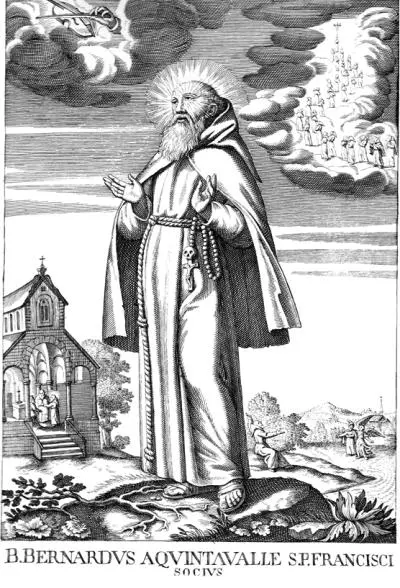
Bernard of Quintavalle (died 1241) was the first disciple of St. Francis of Assisi. Bernard was declared the Minorum Ordinis prima planula, the “First fruits of the Minor Orders.” He accompanied Francis on several missionary journeys and served as Minister Provincial in Spain. Bernard, son of Quintavalle and Berardello, was a well-to-do young noble from Assisi. He received his JUD at Bologna University. His family’s house still stands in Assisi today. Bernard received his evangelical calling in the spring of 1208 when he and Francis had recourse to the Sortes Sanctorum in the church of San Nicolò. After hearing Mass and praying until terce, …the priest, at the request of St. Francis, took the missal and, having made the sign of the most holy cross, opened it three times in the name of our Lord Jesus Christ. At the first opening, they found that saying which Christ spake in the Gospel to the young man which inquired the way of perfection: ‘If thou wilt be perfect, go and sell that thou hast and give to the poor and follow Me.’ At the second opening, they found that saying which Christ spake to the Apostles, when He sent them forth to preach: ‘Take nothing for your journey, neither staff, nor scrip, nor shoes, nor money’; intending thereby to teach them that they ought to set all their hope of living upon God, and to turn all their thoughts to preaching the Holy Gospel. At the third opening of the missal, they found that saying which Christ spake: ‘If any man will come after Me, let him deny himself and take up his cross and follow Me’. Bernard sold everything he had and went to the Square of St. George, where, assisted by Francis, he gave everything to widows, orphans, prisoners, monasteries, hospitals, and pilgrims. In 1211, Francis tasked Bernard with preaching to the worldly and wealthy residents of Bologna. Upon first entering Bologna, because of his appearance, he was mocked and abused as a thief or deserter. Still, after showing Francis’ Rule to the local magistrate, the people’s attitude changed. Bernard subsequently asked Francis to send someone to replace him at Bologna lest he be tempted to pride due to the honour and respect shown to him. Francis then sent Bernard to Lombardy. He was then sent to Florence. After the family of St Clare tried to forcibly remove her from the Benedictine convent of San Paulo near Bastia, Bernard accompanied her to the Benedictine nuns of the convent of Convento di Sant’Angelo di Panzo. In 1213, he accompanied Francis on a missionary journey through Spain, but Francis directed Bernard to remain behind at one point to tend to a poor invalid. When they met again a year later, the sick man had recovered. Francis and Bernard continued through Aragon and Catalonia, Roussillon to Montpellier, and Piedmont back to his chapel at Santa Maria dei Angeli in Assisi. He subsequently became Minister Provincial in Spain until 1219, when John Parenti succeeded him. Together with Angelo Tancredi and Leo of Assisi, Bernard remained close to Francis, especially during the last two years of Francis’ life. St Francis imparted a special blessing to him, although Thomas of Celano reserves this blessing for Elias. After Francis’s death, Bernard had to take Vicar General Elias to task for riding in a large horse-drawn coach, which, to Bernard, was not in accord with the Rule.
Bernard died around 1241 and is buried close to the tomb of St Francis in the Basilica of St Francis in Assisi.
https://en.wikipedia.org/wiki/Bernard_of_Quintavalle
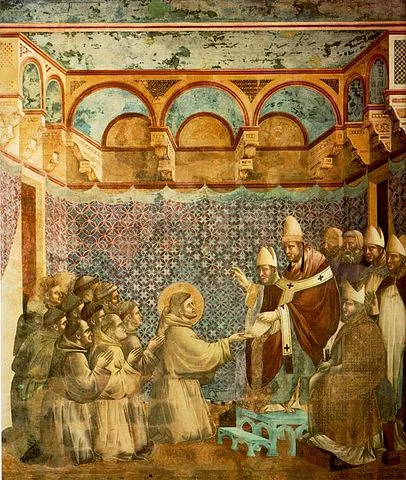
Legend of St Francis: Confirmation of the Rule
Bernard de Quintavalle
Bernard de Quintavalle (né vers 1175 à Quintavalle et mort vers 1241 à Assise) est l’un des premiers disciples, et l’un des plus fidèles et des plus proches collaborateurs de François d’Assise. Issu d’une riche famille patricienne d’Assise, Bernard devient avec Pierre de Catane l’un des premiers compagnons de François d’Assise. Sa famille possède de nombreux biens et il est qualifié de dominus (seigneur) avant sa conversion. Son milieu social d’origine est certainement plus élevé que celui de François. Bernard distribue son patrimoine aux pauvres, comme le décrit Dante Alighieri dans son Paradis (XI, 79-81) : « La concorde [de François et de la Pauvreté] inspiraient des pensers si saints que le vénérable Bernard le premier se déchaussa, et courut à une si grande paix, et courant il lui semblait être lent. » Dès 1209, il se rend à Florence, sa première expédition hors de l’Ombrie, certainement avec le frère Gilles. En 1210, Bernard dirige le groupe de frères venu demander l’approbation de la première règle de François à Rome. Il est ensuite envoyé en mission à Bologne et à Florence, puis accompagne François en Espagne en 1214. Bernard meurt à Assise en 1241 et est enterré dans la basilique Saint-François d’Assise. Il est considéré comme spirituellement le plus proche disciple de François d’Assise.
